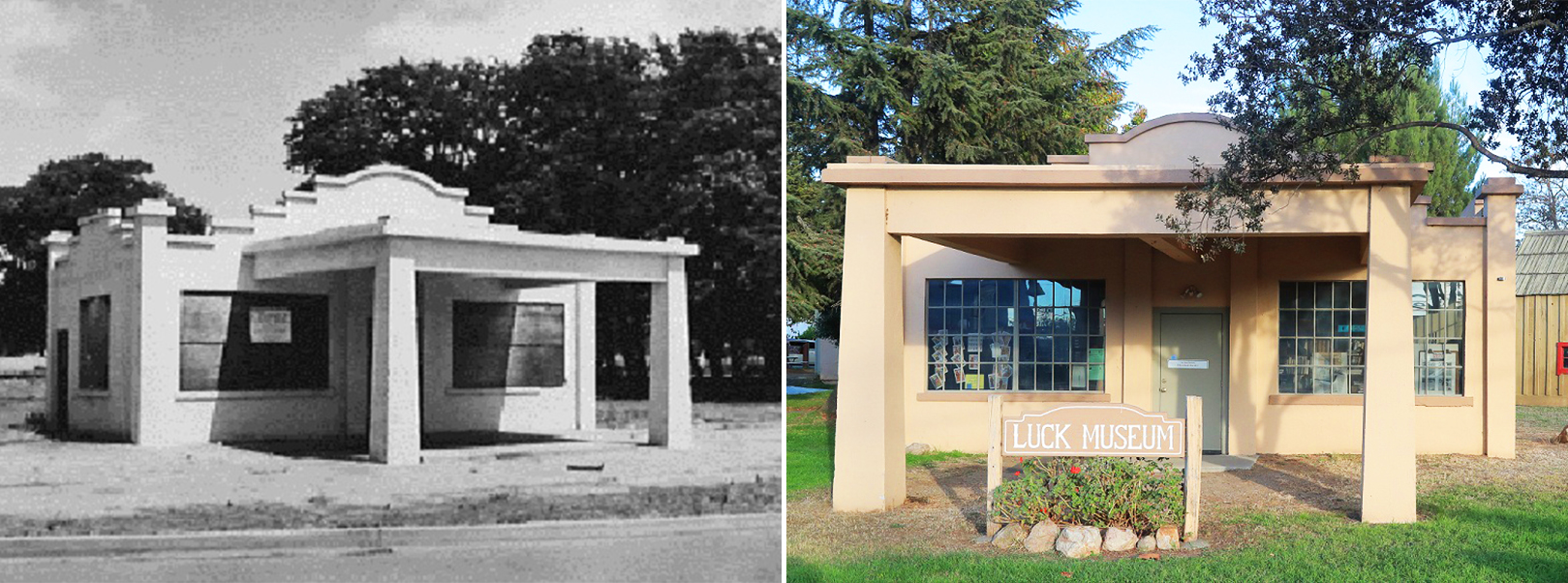Carl Martin Luck Library, Museum, Jim Jack & Park
The Luck Filling Station was built in 1919 at the corner of Third and Monterey Streets, when Third Street was State Highway 101. In the 1920s and 1930s, San Juan Bautista was an important stop for cars traveling between San Francisco and Monterey and boasted nine gas stations. In addition to being one of the early stations in town, Luck Filling Station was also one of the first reinforced poured concrete structures built in the community and is also an example of Mission Style architecture.
The station was at one time a franchise of the Polly Oil Co., which was sold to the Wilshire Oil Co. in 1950. The Wilshire Oil Co. was then sold to Gulf Oil in 1957, but the name continued to be used until 1965. Mohawk was sold to Getty Oil Co. in the early 1970s.
 Born in Germany around 1849, Carl Martin Luck immigrated to the United States in 1890. At some point, he and his family moved to San Juan Bautista, and lived in a three-story Victorian house located at the corner of Second and Tahualami Streets. The family then moved to Salinas but Carl Luck continued to run the filling station.
Born in Germany around 1849, Carl Martin Luck immigrated to the United States in 1890. At some point, he and his family moved to San Juan Bautista, and lived in a three-story Victorian house located at the corner of Second and Tahualami Streets. The family then moved to Salinas but Carl Luck continued to run the filling station.
In 1974, Luck’s daughter Francisca bequeathed her entire estate, including the block bounded by Third, Monterey, Second and Tahualami, to the City of San Juan Bautista, with the provision that the land be used for a new public park, museum and library as a memorial to her father, Carl Martin Luck. The Library was completed in 1979, and the station having long been closed became the museum in June, 2000 and is home of the San Juan Bautista Historical Society.
Jim Jack Cabin
During the late 1800’s, a Chinese man named Jim Jack lived in the one-room “board-on-end” cabin that stands behind the Luck Museum. Its original location was on Mission Vineyard Road west of the City limits, and was moved in 2006. Jim Jack was known as “The Mustard King” for his work clearing wild mustard from the grain fields in the San Juan Valley and selling the mustard seeds to French mustard manufacturers and restaurants in San Francisco for large sums money.
The Flint-Bixby Company had hired Jack in 1880 to poison the squirrel pests burrowing the San Juan Valley land it leased to farmers. Jack also cooked for the hired hands who the company employed. During the wheat harvest season every year, local farmers faced the headache of removing wild mustard growing among their grain. When the grain was threshed, a cleaner separated the mustard weeds from the wheat and threw the mustard debris into large piles to dispose of later. Jim Jack wisely collected the mustard seed to sell to local stores and restaurants, and went on to sell the product to French mustard manufacturers.
Jim Jack was well known as a kind and generous man who used his wealth to help his town neighbors by donating candy to the schools, mincemeat, raisins and candies to families of San Juan during the holidays, and sacks of flour and vegetables to the laboring men’s families. Jim Jack eventually returned to China in 1920 to live out his remaining years
Supported By 24x7 WP Support Desk
